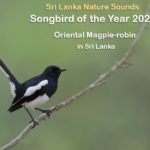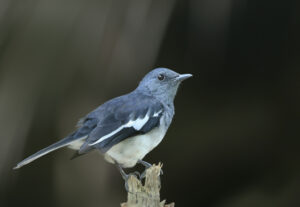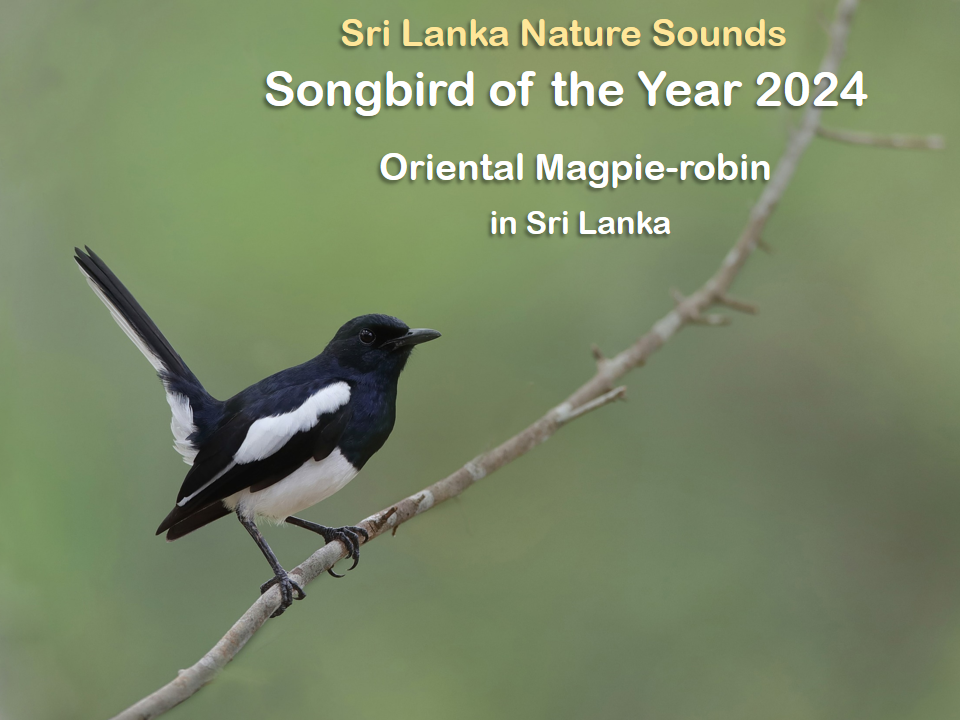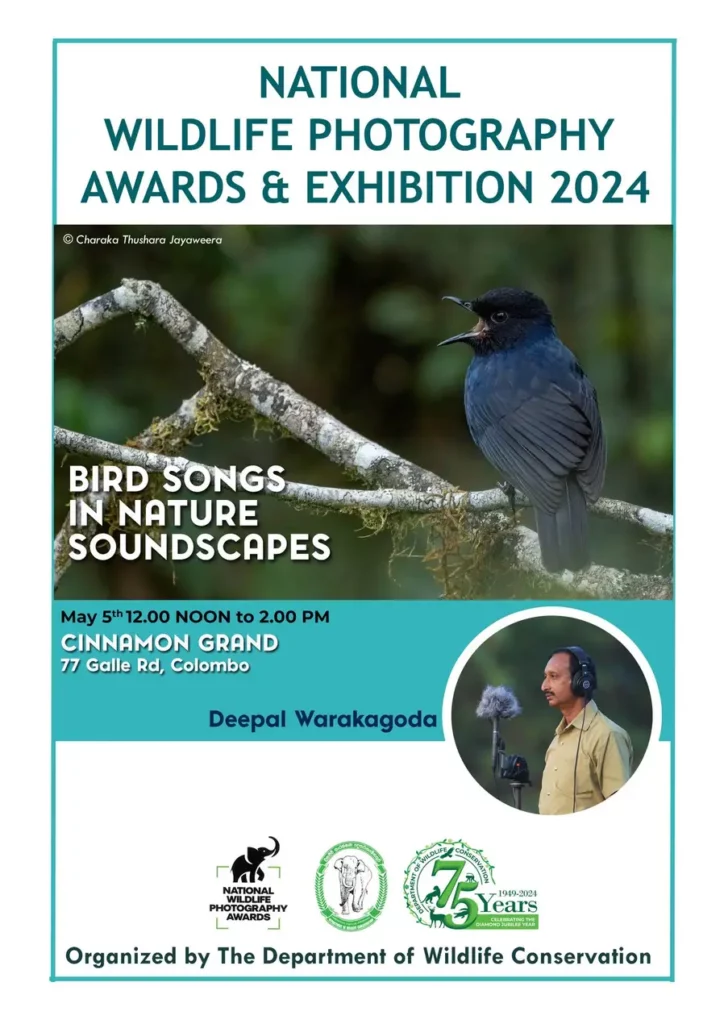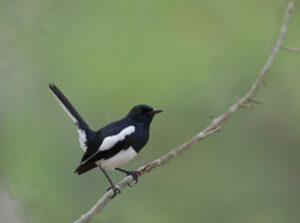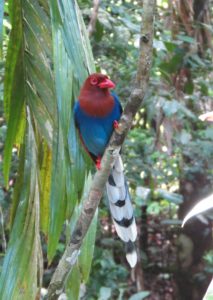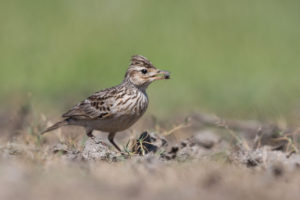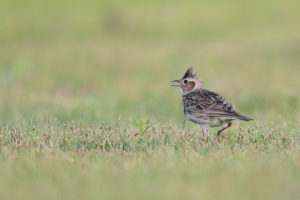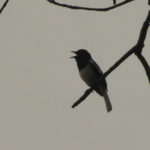The Master of Garden Birdsong
Oriental Magpie-robin in urban and suburban environments. Is it thriving?
Deepal Warakagoda, 13 May 2024
The Oriental Magpie-robin in Sri Lanka
The Oriental Magpie-robin (Copsychus saularis) or Polkichcha (in Sinhala) and Katikuruvi (in Tamil) is a very familiar garden bird throughout the country. It’s doubtful that there’s anyone out there (with normal hearing) who has not heard the voice of the magpie-robin in the vicinity of their home, whether paying attention to its sounds or not. The magpie-robin is a songbird, not just an ordinary one but a master of singing, at which it can challenge all but very few bird species in the world. The singing is powerful, far-carrying and often includes melodious passages. Songs of male magpie-robins resound in every part of the country, except the interior of rainforests and cloud forests, in many months of the year. These are some reasons for Sri Lanka Nature Sounds to choose this bird as Sri Lanka’s first ‘Songbird of the Year’ in 2024 (see here).
Magpie-robin as a songbird
The Oriental Magpie-robin belongs to a distinct group recognized as ‘true’ songbirds, or ‘turdiform’ (thrush-like) birds in the Superfamily Muscicapoidea under the Order Passeriformes. They have a remarkable ability in singing and have a widely varied song repertoire. They can sing notes of different pitches in a rapid succession or even lower and higher pitched notes at the same time, producing complex, modulated and highly variable song. The songs are melodious, which is pleasing to us. The magpie-robin has this ability at the highest level among the songbirds (see here).
A preliminary study
I have been studying a few pairs of magpie-robins in the larger vicinity of my residence at Udahamulla in the suburbs of Colombo for 17 years now (since 2007). My observations have been mostly focussed on their singing and related behaviour. However, I have observed and audio recorded songs of the magpie-robin since 1991 in many areas of the country, though roughly in the western half, from Jaffna in the North to Yala in the South-east. These recordings are archived at the Drongo Nature Sounds Library. Throughout the 17 years my main focus has been on the pairs in my vicinity which live in a suburban environment.
Magpie-robins in our cities and suburbs – are they on a silent decline?
A good number of magpie-robin pairs are readily found in urban and suburban areas of Colombo. It may well appear to anyone noting this that the species is thriving in this environment. Male magpie-robins sing more or less continuously for about eight to ten months (mostly from October to June or August of the following year) during their breeding season. This prolonged singing might make one think that there is successful breeding every year.
However, my observations in my area in these past years suggest that the pairs here do not succeed in producing young for a number of years. During these 17 years I have observed not more than 11 young birds born in the larger vicinity of my residence. The pair occupying my and a few neighbouring gardens as part of its territory during this time had only three young ones! All sightings of the species showed only one young bird for a pair. This poor rate of breeding success is of great concern.
Magpie-robins appear to be fairly long lived birds, apparently over 17 years, from personal observation of two singing males in my near vicinity since 2007. It is not clear whether: having fewer offspring is a natural phenomenon to cope with increasing demand to establish new territories for males in decreasing habitat in urban and suburban environments; or suitable nesting sites in this environment are diminishing; or nests are often disturbed or predated thus preventing pairs from incubating eggs or raising young; or there is a lack of food, maybe sources of protein, to raise young successfully in successive years; or yet other causes are involved.
We need to seek answers for the deficiency in breeding to see whether our urban and suburban magpie-robins require appropriate attention from us, to also have them continue singing in our home gardens. It is also important to assess the situation with the pairs of magpie-robins in rural areas to compare the two populations.
For these reasons I think it is important to have information gathered from many urban and suburban areas, and from rural areas too, to assess the situation with regard to the magpie-robin pairs in cities and adjacent areas.
If you are interested in sharing some observations from the area you live in I would like to invite you to join the following facebook group. What is requested from you are reports: of magpie-robins singing, as all singing indicates attempted or successful breeding; of them nesting, which is done typically in tree hollows; and of the presents of young ones, described below.
How to detect the magpie-robins in your area
Magpie-robins are highly territorial birds throughout the year. The two birds of a pair occupy an area which they have separated clearly for themselves from other magpie-robin pairs in surrounding areas. Hence the pair in an area is easy to detect most of the year, especially the male as it sings for a number of months in a row in the year from every vantage position within its territory. The female is less easily detected except when she stays in the vicinity of the singing male or is feeding on the ground nearby. If she is incubating then there is minimal chance to find her. Sometimes the two are seen together also when the male chases after her calling loudly in courtship. If there’s a bird feeding table in your vicinity then it is very likely you will see the pair here either singly or together at various times of the day. During the period, the months of year, the male is not singing the places to detect the birds of a pair are the regular feeding sites in their territory. Young birds accompany one or both parents for a few weeks after they are fledged out of the nest.
You can see below the images and identification captions of male, female and young birds of the magpie-robin.
Male, deep blue-black upperparts and breast with white underparts and wing-stripe.
(Photo by Uditha Hettige)
Female, duller than male with greyer on upperparts and breast.
(Photo by Uditha Hettige)
Young bird, resembles an adult female but duller and has small brown spots on throat to breast and brown on wings.
Older young bird, more like an adult female but has some brown spots on throat, breast and head, and brown on wings.
Join our facebook group to share your observations of the magpie-robin in your home garden – facebook group
